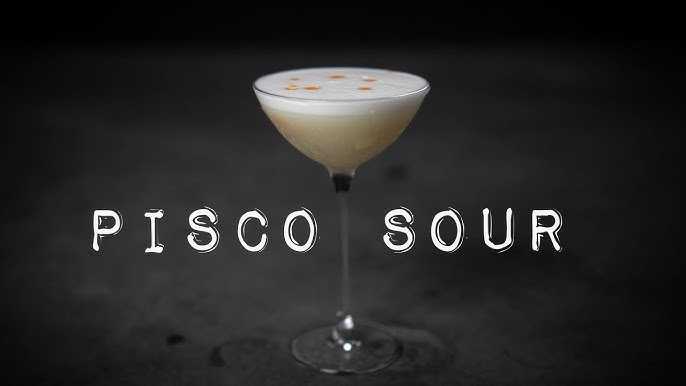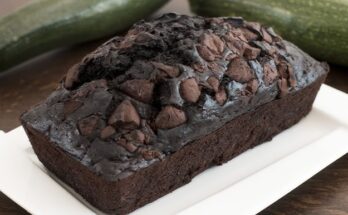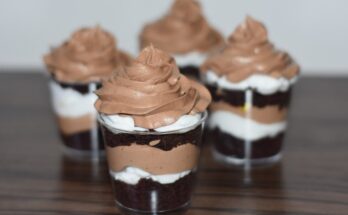Pisco Sour Recipe: If you’ve ever wanted a cocktail that perfectly balances tart, sweet, and boozy in one silky sip, then the Pisco Sour might just be your new favorite drink. Originating from South America, this cocktail is made with pisco (a grape brandy), freshly squeezed lime juice, simple syrup, egg white, and a dash of bitters. It’s known for its frothy top, smooth finish, and bright citrusy punch that hits all the right notes.
Unlike overly sugary mixed drinks, the Pisco Sour keeps things elegant. The egg white gives it a foamy, velvety texture, while the lime juice adds that zesty freshness. The pisco itself brings a unique fruity aroma that sets it apart from typical base spirits like vodka or gin.
Whether you’re looking to impress guests or just shake up your evening drink game, this cocktail is surprisingly easy to make—and oh so rewarding to drink.
A Brief History of the Pisco Sour
The origins of the Pisco Sour are steeped in South American heritage, with both Peru and Chile claiming ownership of this iconic cocktail. Most historians lean toward Peru as its birthplace, with bartender Victor Vaughen Morris often credited with creating the first modern version in Lima around the early 1920s.
Originally, the Pisco Sour was a simple mix of pisco and lemon juice. Over time, bartenders started adding egg white for texture and bitters for aroma, transforming it into the cocktail we know today. In fact, the drink is so embedded in Peruvian culture that Peru celebrates “National Pisco Sour Day” on the first Saturday of February.
While the debate over its true origin continues between Peru and Chile, there’s no denying that the Pisco Sour has earned its place as a beloved international cocktail.
Why It’s a Must-Try Cocktail
You might wonder, “Why go through the trouble of making a Pisco Sour when there are so many simpler drinks?” Simple: it’s an experience. A well-made Pisco Sour is more than just a drink—it’s a balance of art and science.
First, there’s the sensory experience. You get a burst of citrus on the nose, followed by the smooth, sweet-tart taste, and then that creamy finish from the egg white foam. Then there’s the visual appeal—bright white froth with those classic bitters drops dancing on top.
Beyond that, it’s a conversation starter. Serve it at a gathering, and you’ll have people asking, “What is this?” and “How did you make it?” Plus, it’s a way to expand your cocktail-making skills and impress anyone lucky enough to taste your creation.
Ingredients for a Perfect Pisco Sour
Key Ingredients and Their Role
To create the perfect Pisco Sour, it’s important to understand the function of each ingredient. This isn’t just a mix-it-and-hope-for-the-best kind of drink. Every element plays a key role in achieving that perfect balance:
- Pisco (2 oz): The heart of the cocktail. It’s a grape brandy, either from Peru or Chile, and offers a floral, fruity aroma with a slightly spicy undertone.
- Lime Juice (1 oz): Adds acidity and freshness. Always go for freshly squeezed—bottled juice doesn’t deliver the same brightness.
- Simple Syrup (¾ oz): Provides sweetness to balance the lime. It’s just sugar dissolved in water, typically in a 1:1 ratio.
- Egg White (1): Gives the drink its iconic foam and silky texture. Don’t worry—it’s safe if you use fresh eggs.
- Angostura Bitters (a few drops): Just a dash for aroma and a slight bitter edge. It also makes for a beautiful garnish swirl on the foam.
Each ingredient brings a specific texture or flavor component. Leave one out, and the balance could fall apart.
Choosing the Right Pisco
Not all piscos are created equal. Peruvian pisco tends to be purer and more aromatic, made without any aging or additives. You’ll find several varieties like Quebranta, Italia, and Acholado, each offering different flavor profiles. Chilean pisco, on the other hand, can be aged and usually comes with a smoother, mellower taste.
For beginners, go for a Quebranta pisco—it’s versatile, smooth, and perfect for cocktails. More adventurous drinkers might enjoy the floral notes of Italia or the complexity of an Acholado blend.
Substitutes and Variations
Can’t find pisco? While it won’t be a true Pisco Sour, you can substitute with unaged brandy or grappa in a pinch. It won’t replicate the exact flavor, but it gets you close.
Want to shake things up a bit? Try these variations:
- Passion Fruit Pisco Sour: Add passion fruit puree for a tropical twist.
- Chili-Infused Pisco Sour: Infuse the simple syrup with chili for a spicy kick.
- Ginger Pisco Sour: Muddle fresh ginger before shaking for a zesty surprise.
Each twist brings something fresh to the table while still honoring the cocktail’s roots.
Equipment You’ll Need
Cocktail Shaker Essentials
Making a Pisco Sour the right way means investing in a few bar tools. The most important? A good cocktail shaker. A Boston shaker or cobbler shaker will do the trick. You’ll also need a jigger (for precise measuring), a strainer, and optionally, a bar spoon for layering or stirring.
These tools help ensure your cocktail isn’t just tasty—it’s consistent every time. A proper shake also helps emulsify the egg white, which is key to getting that luscious foam on top.
The Importance of Fresh Tools
Using clean, fresh tools might seem obvious, but it makes a difference. Old or unwashed equipment can carry residue that changes the flavor of your drink. Always rinse your tools before and after use. Trust me, your tastebuds will thank you.
Step-by-Step Pisco Sour Recipe
Step 1: Measure Your Ingredients
Precision is the name of the game when it comes to crafting a stellar Pisco Sour. The difference between a drink that wows and one that underwhelms often comes down to the measurements. Here’s your golden ratio:
- 2 oz Pisco
- 1 oz fresh lime juice
- ¾ oz simple syrup
- 1 egg white
- A few drops of Angostura bitters
Grab your jigger and measure each ingredient carefully. This cocktail isn’t the time to eyeball things. Too much lime juice? Your drink will be overly sour. Skimp on the simple syrup? It’ll come out too sharp. You want the sweet-tart balance to sing—not scream.
Measuring also ensures consistency. When your friends inevitably ask for a second round (and they will), you’ll want it to taste exactly like the first masterpiece you served.
Step 2: Dry Shake Without Ice
This is the magic step. A “dry shake” means shaking all the ingredients without ice. Why? Because it’s the best way to emulsify the egg white and create that luxurious, foamy top that defines the Pisco Sour.
Combine all your ingredients—pisco, lime juice, simple syrup, and egg white—into your cocktail shaker. Make sure the lid is tight (because no one wants cocktail foam all over the kitchen), and then shake it like you mean it for a solid 15-20 seconds.
Don’t rush this step. The more air you whip into the egg white now, the better the foam will look and feel when you pour it into the glass later. Think of it like shaking up a tiny storm of flavor and texture.
Step 3: Add Ice and Shake Again
After your dry shake, it’s time to chill things down. Open up your shaker, toss in a generous scoop of ice, seal it back up, and shake again—this time for about 10-15 seconds.
The second shake chills the drink and slightly dilutes it, helping to mellow the bold acidity and bring all the flavors together. You’ll feel the shaker get icy cold in your hands. That’s your cue that it’s ready.
This two-step shaking process might seem like extra effort, but it’s crucial. It creates that smooth texture, icy chill, and velvety foam all at once. Skip this, and your Pisco Sour will fall flat—literally.
Step 4: Strain and Serve
Now comes the most satisfying part—pouring your creation into a glass. Grab a coupe or old-fashioned glass (both work beautifully) and use a fine mesh strainer to catch any ice shards or pulp as you pour.
The drink should be pale, creamy, and topped with a generous head of foam. That’s the signature look of a proper Pisco Sour. If your foam is flat or barely there, it means you didn’t shake hard or long enough during the dry shake.
Take a second to admire your handiwork. This isn’t just a cocktail—it’s a layered, textured piece of art in a glass.
Step 5: Garnish with Angostura Bitters
Finally, let’s finish strong. The last touch is a few drops of Angostura bitters on top of the foam. You don’t need much—three small dots in a triangle pattern is the classic look.
But if you’re feeling artsy, grab a toothpick and drag it through the drops to create hearts or swirls. It’s a little flair that turns your drink from “nice” to “Instagram-worthy.”
Beyond aesthetics, those few drops add a complex aroma that enhances every sip. The bitters float right on the foam, so as you bring the glass to your lips, you get that spicy herbal scent just before the limey zing and smooth pisco hit your tongue.
Tips for the Best Pisco Sour
Getting the Foam Just Right
That iconic foam isn’t just for looks—it’s part of the whole sensory experience. A proper Pisco Sour should have a firm but airy top layer that lingers as you sip. Getting that foam right takes a few tricks:
- Use fresh egg whites – Older eggs don’t foam as well.
- Shake hard – The dry shake needs real elbow grease.
- Let it settle – After pouring, give the foam 30 seconds to rise and firm up.
If you’re vegan or uncomfortable using raw egg, you can substitute with aquafaba (chickpea water). Use 1 oz of aquafaba in place of egg white. It gives nearly identical foam without any animal products.
Balancing Sweetness and Acidity
This drink lives and dies by its balance. Too sour, and it’s like biting into a lime. Too sweet, and it turns into a dessert. The 1 oz lime to ¾ oz simple syrup ratio is a great starting point, but feel free to tweak it to your taste.
Here are a few pointers:
- Taste your lime juice – Some limes are more tart than others.
- Use quality simple syrup – Homemade is best: 1 part sugar, 1 part water, heated until dissolved and cooled.
- Don’t be afraid to adjust – Try a test cocktail first and dial it in.
If your first attempt is too sharp, add a touch more syrup. If it’s too sweet, squeeze a little more lime. Finding your perfect ratio is part of the fun.
Common Mistakes to Avoid When Making a Pisco Sour
Using Bottled Lime Juice
Let’s be real—nothing kills a fresh cocktail faster than bottled lime juice. It lacks the bright, zesty punch that only freshly squeezed lime can deliver. Not to mention, the preservatives and added sugars mess with the delicate balance of the cocktail. If you’re going through the effort of making a Pisco Sour, take the extra minute to squeeze fresh limes. Your taste buds will thank you.
Skipping the Dry Shake
We’ve mentioned it before, but it’s worth repeating—don’t skip the dry shake. Without it, the egg white won’t foam properly, and you’ll be left with a flat, lifeless cocktail. Think of this as the “fluff” step—it’s what gives the drink that Instagram-worthy top layer and a luxurious mouthfeel.
Overdiluting with Ice
Too much ice or shaking too long with ice can water down your drink. You want it cold, not bland. Stick to a 10–15 second shake once the ice goes in. If you overdo it, the cocktail loses its vibrant flavor and becomes just… meh.
Using the Wrong Pisco
Different types of pisco can dramatically affect the flavor. Go with a pisco that’s meant for mixing—ideally a Quebranta or an Acholado. Some piscos are better suited for sipping and may not blend well with citrus and sugar.
Improper Garnishing
It may seem minor, but the garnish plays a big role. A few strategic drops of Angostura bitters on the foam not only look classy but also add a subtle aromatic layer. Forget the garnish, and you miss out on that final flavor lift.
Best Occasions to Serve a Pisco Sour
Dinner Parties and Cocktail Hours
Pisco Sours are show-stoppers. Their look, texture, and unique flavor always get people talking. They’re an excellent choice for dinner parties where you want to offer something impressive yet approachable. Serve them before dinner to kick off the evening with a zing.
Celebrations and Toasts
Thanks to its light yet flavorful profile, the Pisco Sour is a perfect celebratory drink. It’s less heavy than cream-based cocktails and more festive than a basic gin and tonic. Whether it’s a birthday, a wedding toast, or a small win at work, this cocktail elevates the mood instantly.
Summer Sipping and Outdoor Events
That citrusy freshness makes Pisco Sours ideal for warm-weather sipping. Think garden brunches, rooftop gatherings, or poolside chill-outs. They’re refreshing without being too sweet and won’t weigh you down like heavier drinks.
Impressing Guests with Something Unique
Tired of serving the same old margaritas or mojitos? A Pisco Sour is just different enough to stand out, yet simple enough for anyone to enjoy. It’s a great way to introduce people to new spirits and flavors they might not have tried before.
Pisco Sour Variations Worth Trying
Passion Fruit Pisco Sour
Swap out part of the lime juice for passion fruit puree. It brings a tropical twist that adds sweetness and a beautiful golden color. This version is especially popular in Peru and offers a more exotic flavor profile.
Spicy Pisco Sour
Infuse your simple syrup with fresh chili peppers or jalapeños. The heat adds a bold contrast to the sweetness and citrus, giving your cocktail a fiery edge. Great for spice lovers who enjoy a bit of a kick in their sip.
Pineapple or Mango Pisco Sour
Fruity versions like pineapple or mango Pisco Sours are tropical, smooth, and dangerously easy to drink. Blend or muddle fresh fruit, strain, and mix into the traditional recipe for a sun-kissed variation that screams vacation vibes.
Cucumber Basil Pisco Sour
Looking for something herbaceous and refreshing? Add muddled cucumber and basil for a garden-fresh spin on the classic. It’s light, crisp, and super aromatic—ideal for spring and summer occasions.
Nutritional Information and Dietary Considerations
Calories in a Pisco Sour
A typical Pisco Sour contains around 200-250 calories depending on how sweet you make it and the size of your pour. Here’s a rough breakdown:
| Ingredient | Amount | Calories |
|---|---|---|
| Pisco | 2 oz | 130-140 |
| Lime Juice | 1 oz | 10 |
| Simple Syrup | ¾ oz | 50 |
| Egg White | 1 | 15 |
| Bitters (drops) | – | Negligible |
Gluten-Free and Dairy-Free
Good news: a classic Pisco Sour is naturally gluten-free and dairy-free. Just make sure your simple syrup doesn’t have any hidden additives, and you’re good to go.
Vegan Substitutes
If you’re vegan or allergic to eggs, aquafaba (chickpea brine) is the go-to substitute for egg whites. Use about 1 oz to mimic the foam without any animal products. The taste difference is barely noticeable, especially with quality ingredients.
FAQs about Pisco Sour Recipe
1. What is Pisco?
Pisco is a type of brandy produced in Peru and Chile. It’s made from distilled grape wine and is the key ingredient in making a classic Pisco Sour.
2. What ingredients do I need for a Pisco Sour?
To whip up a traditional Pisco Sour, you’ll need Pisco, freshly squeezed lime juice, simple syrup, egg white, and a dash of Angostura bitters for garnish.
3. Is an egg white necessary in a Pisco Sour?
Yes, the egg white is essential as it gives the Pisco Sour its signature frothy top. However, for a vegan option, you can substitute it with aquafaba (the liquid from canned chickpeas).
4. How do I achieve the perfect froth?
The key to a perfect froth is vigorous shaking. First, dry shake (shake without ice) the ingredients to allow the egg white to emulsify, then add ice and shake again until well-chilled.
5. Can I make a Pisco Sour without a cocktail shaker?
While a cocktail shaker is ideal, you can use any jar with a tight-sealing lid as a makeshift shaker. Just ensure you shake vigorously to properly mix and froth the ingredients.
6. What’s the difference between a Peruvian and a Chilean Pisco Sour?
The main difference lies in the Pisco used. Peruvian Pisco is often single-grape and pot-distilled, offering a distinct flavor. Chilean Pisco can be multi-grape and continuously distilled. Additionally, Chilean versions sometimes skip the bitters and egg white.
7. How do I store Pisco?
Store Pisco in a cool, dark place much like you would with other spirits. Properly stored, Pisco can last for several years.
8. Are there any variations of the Pisco Sour?
Absolutely! Variations include adding fruit like passionfruit or mango, or herbs like cilantro for a twist on the traditional recipe.
Conclusion
Whether you’re new to cocktails or a seasoned mixologist, the Pisco Sour is a must-have in your repertoire. It’s elegant, refreshing, and packed with character. With its balanced flavors and luxurious texture, it’s the kind of drink that never gets old.
Take your time, follow the steps, and don’t skip the foam. From casual dinners to grand celebrations, the Pisco Sour brings sophistication and style to any occasion.
Now that you’ve got the knowledge—shake it up and sip away!



